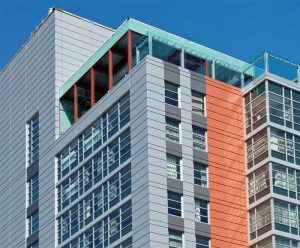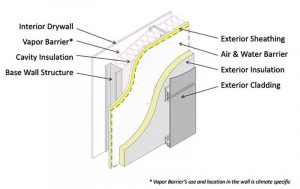by Eric W. Banks and Jeffrey H. Greenwald, P.E., CAE

Structure fires have dropped significantly over the past 40 years, and one major contributor to this decline in fires and fire deaths has been the development of comprehensive fire safety measures. These include performance testing requirements of model building codes.
Building codes in the United States regulate the use of plastics, foam plastic insulation, and other combustible materials used in the building envelope through a robust combination of reference standards, material fire tests and complete assembly fire performance requirements. Combined with other building and fire code requirements—such as compartmentation, active fire suppression sprinklers, egress provisions, and height and area limitations based on building type and occupancy—these provisions for the building assembly produce cooperative layers of fire safety. It is these multiple layers of fire safety, not a single requirement, which result in safe construction.
Modern wall assemblies have become increasingly complex as critical elements of the building enclosure. Advancements in our understanding of building science, coupled with the need to improve energy efficiency and resilience of buildings, have led to innovative solutions in both building products and construction methods. Many of the innovative products available today are subject to compliance with prescriptive fire testing and performance requirements as regulated under the International Building Code (IBC). One of the critical prescribed fire tests within the IBC for exterior wall assemblies is the National Fire Protection Association (NFPA) 285, Standard Fire Test Method for Evaluation of Fire Propagation Characteristics of Exterior Wall Assemblies Containing Combustible Components. This article discusses code aspects regarding fire safe construction and engineering judgments, and their use as a practical tool that can assist designers and building officials with assessing the compliance of exterior wall assemblies with the acceptance criteria of NFPA 285 (Figure 1).
The International Building Code
The IBC is recognized as the model building code for commercial construction, which is then adopted by state and local jurisdictions. Increasing use of energy efficient continuous insulation (ci) and innovative wall assemblies places a greater emphasis on fire performance of exterior walls; this is regulated under the IBC through NFPA 285.
Generally, NFPA 285 testing is required for combustible exterior wall assemblies containing combustible cladding, foam plastic insulation, or combustible water resistive barriers (WRB) installed on Types I, II, III, IV buildings of certain heights. Type V construction does not require NFPA 285 testing. The 2021 IBC regulates the fire safety of exterior walls containing combustible claddings, WRBs and foam plastic insulation in Chapter 14, “Exterior Walls” and Chapter 26, “Plastic.”
Chapter 14 of the IBC regulates the minimum requirements for exterior walls; exterior wall coverings; openings in the exterior wall; exterior windows and doors; and architectural trim. The provisions of Chapter 14 detail performance requirements regarding weather protection, structural performance, moisture control, reaction to fire, and flood resistance. IBC Chapter 26 contains provisions for the use of foam plastic insulation in exterior walls.
The IBC also establishes minimum requirements for building systems using prescriptive and performance-related provisions. Section 104.11, “Alternative materials, design and methods of construction and equipment,” allows the use of alternate methods, etc. with strict guidance. Approval is granted on the basis of the building official’s finding that the alternative, “…is satisfactory and complies with the intent of the provisions of this code, and that the material, method or work offered is, for the purpose intended, not less than the equivalent of that prescribed in this code in quality, strength, effectiveness, fire resistance, durability and safety.”
The model codes recognize principles of fire science and fire protection engineering allow for the reasonable extension of test results to modifications of tested assemblies using comparative analysis of pertinent fire test data. For example, IBC Chapter 7, “Fire and Smoke Protection Features” contains provisions in IBC Section 703.2 and 716.1.1 that permit the use of engineering analysis to determine fire resistance.

For those situations where the code does not provide prescriptive provisions, Section 104.11 provides building officials with duties and powers to consider supporting information such as test data and engineering analysis in their review and approval of alternative materials, designs, and methods of construction as meeting the intent of the code. Both Sections 703.2 and 716.1.1 include reference to Section 104.11 as a compliance method. Engineering analyses that extend NFPA 285 results to modifications of tested assemblies are within the scope and intent of IBC 104.11.




